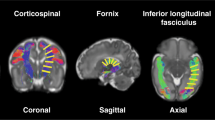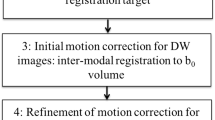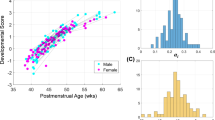Abstract
Objective
We aimed to determine the timing for assessing birth status of the developing brain (i.e. brain maturity at birth) by exploring the postnatal age-related changes in neonatal brain white matter (WM).
Methods
The institutional review board approved this study and all informed parental consents were obtained. 133 neonates (gestational age, 30–42 weeks) without abnormalities on MRI were studied with regard to WM development by diffusion tensor imaging-derived fractional anisotropy (FA). Tract-based spatial statistics (TBSS), locally-weighted scatterplot smoothing (LOESS) and piecewise linear-fitting were used to investigate the relationship between FA and postnatal age. FA along corticospinal tract (CST), optic radiation (OR), auditory radiation (AR) and thalamus-primary somatosensory cortex (thal-PSC) were extracted by automated fibre-tract quantification; their differences and associations with neonatal neurobehavioural scores at various postnatal age ranges were analysed by Wilcoxon’s rank-sum test and Pearson’s correlation.
Results
Using TBSS, postnatal age (days 1–28) positively correlated with FA in multiple WMs, including CST, OR, AR and thal-PSC (p<0.05). On the other hand, when narrowing the postnatal age window to days 1–14, no significant correlation was found, suggesting a biphasic WM development. LOESS and piecewise linear-fitting indicated that FA increased mildly before day 14 and its growth accelerated thereafter. Both FA and correlations with neurobehavioural scores in postnatal age range 2 (days 15–28) were significantly higher than in range 1 (days 1–14) (FA comparison: p<0.05; maximal correlation-coefficient: 0.693 vs. 0.169).
Conclusion
Brain WM development during the neonatal stage includes two phases, i.e. a close-to-birth period within the first 14 days and a following accelerated maturation period. Therefore, evaluations of birth status should preferably be performed during the first period.
Key Points
• Brain white matter development within the first two postnatal weeks resembles a close-to-birth maturation.
• Brain white matter development in the audio-visual, sensorimotor regions accelerates after two postnatal weeks.
• Postnatal age-related effects should be considered in comparing preterm and term neonates.




Similar content being viewed by others
Abbreviations
- AR:
-
Auditory radiation
- CST:
-
Corticospinal tract
- DTI:
-
Diffusion tensor imaging
- FA:
-
Fractional anisotropy
- GA:
-
Gestational age
- LOESS:
-
Locally-weighted scatterplot smoothing
- MR imaging:
-
Magnetic resonance imaging
- OR:
-
Optic radiation
- TBSS:
-
Tract-based spatial statistics
- thal-PSC:
-
Thalamus-primary somatosensory cortex
- WM:
-
White matter
References
Public Health England (2016) Newborn and infant physical examination: programme handbook. Available via https://www.gov.uk/government/publications/newborn-and-infant-physical-examination-programme-handbook. Accessed 15 Dec 2017
Buonocore G, Bracci R, Weindling M (2012) Neonatology. Springer, Milano
Dubois J, Dehaene-Lambertz G, Perrin M et al (2008) Asynchrony of the early maturation of white matter bundles in healthy infants: quantitative landmarks revealed noninvasively by diffusion tensor imaging. Hum Brain Mapp 29:14–27
Huang H, Zhang J, Wakana S et al (2006) White and gray matter development in human fetal, newborn and pediatric brains. Neuroimage 33:27–38
Qiu A, Mori S, Miller MI (2015) Diffusion tensor imaging for understanding brain development in early life. Annu Rev Psychol 66:853–876
Stoll BJ, Hansen NI, Bell EF et al (2015) Trends in care practices, morbidity, and mortality of extremely preterm neonates, 1993-2012. JAMA 314:1039–1051
Patel RM, Kandefer S, Walsh MC et al (2015) Causes and timing of death in extremely premature infants from 2000 through 2011. N Engl J Med 372:331–340
Plaisier A, Govaert P, Lequin MH, Dudink J (2014) Optimal timing of cerebral MRI in preterm infants to predict long-term neurodevelopmental outcome: a systematic review. AJNR Am J Neuroradiol 35:841–847
Smyser CD, Kidokoro H, Inder TE (2012) MRI of the brain at term equivalent age in extremely premature neonates - to scan or not to scan? J Paediatr Child Health 48:794–800
de Bruïne FT, van den Berg-Huysmans AA, Leijser LM et al (2011) Clinical implications of MR imaging findings in the white matter in very preterm infants: a 2-year follow-up study. Radiology 261:899–906
Dubois J, Dehaene-Lambertz G, Kulikova S, Poupon C, Hüppi PS, Hertz-Pannier L (2014) The early development of brain white matter: a review of imaging studies in fetuses, newborns and infants. Neuroscience 276:48–71
Tauber H, Waehneldt TV, Neuhoff V (1980) Myelination in rabbit optic nerves is accelerated by artificial eye opening. Neurosci Lett 16:235–238
Berman JI, Glass HC, Miller SP et al (2009) Quantitative fiber tracking analysis of the optic radiation correlated with visual performance in premature newborns. AJNR Am J Neuroradiol 30:120–124
Broekman BF, Wang C, Li Y et al (2014) Gestational age and neonatal brain microstructure in term born infants: a birth cohort study. PLoS One 9:e115229
Partridge SC, Mukherjee P, Henry RG et al (2004) Diffusion tensor imaging: serial quantitation of white matter tract maturity in premature newborns. Neuroimage 22:1302–1314
Mukherjee P, McKinstry RC (2006) Diffusion tensor imaging and tractography of human brain development. Neuroimaging Clin N Am 16:19–43
Hüppi PS, Dubois J (2006) Diffusion tensor imaging of brain development. Semin Fetal Neonatal Med 11:489–497
[No authors listed] (1992) American Academy of Pediatrics Committee on Drugs: Guidelines for monitoring and management of pediatric patients during and after sedation for diagnostic and therapeutic procedures. Pediatrics 89:1110–1115
Bao XL, Yu RJ, Li ZS, Zhang BL (1991) Twenty-item behavioral neurological assessment for normal newborns in 12 cities of China. Chin Med J (Eng) 104:742–746
Dubowitz LMS, Dubowitz V, Mercuri E (1999) The neurological assessment of the preterm and full-term newborn infant, 2nd edn. Mac Keith Press, London
Fortin JP, Parker D, Tunç B et al (2017) Harmonization of multi-site diffusion tensor imaging data. Neuroimage 161:149–170
Li X, Gao J, Wang M, Wan M, Yang J (2016) Rapid and reliable tract-based spatial statistics pipeline for diffusion tensor imaging in the neonatal brain: applications to the white matter development and lesions. Magn Reson Imaging 34:1314–1321
Fjell AM, Walhovd KB, Westlye LT et al (2010) When does brain aging accelerate? Dangers of quadratic fits in cross-sectional studies. Neuroimage 50:1376–1383
Tanaka-Arakawa MM, Matsui M, Tanaka C et al (2015) Developmental changes in the corpus callosum from infancy to early adulthood: a structural magnetic resonance imaging study. PLoS One 10:e0118760
Chen H, Zhao B, Cao G et al (2016) Statistical approaches for the study of cognitive and brain aging. Front Aging Neurosci 8:176
Yeatman JD, Dougherty RF, Myall NJ, Wandell BA, Feldman HM (2012) Tract profiles of white matter properties: automating fiber-tract quantification. PLoS One 7:e49790
Oishi K, Mori S, Donohue PK et al (2011) Multi-contrast human neonatal brain atlas: application to normal neonate development analysis. Neuroimage 56:8–20
Gilmore JH, Lin W, Corouge I et al (2007) Early postnatal development of corpus callosum and corticospinal white matter assessed with quantitative tractography. AJNR Am J Neuroradiol 28:1789–1795
Kollias S (2012) Insights into the connectivity of the human brain using DTI. NJR 1:78–91
Hinkley LBN, Marco EJ, Findlay AM et al (2012) The role of corpus callosum development in functional connectivity and cognitive processing. PLoS One 7:e39804
Dean DC 3rd, Planalp EM, Wooten W et al (2017) Mapping white matter microstructure in the one month human brain. Sci Rep 7:9759
Nossin-Manor R, Card D, Morris D et al (2013) Quantitative MRI in the very preterm brain: assessing tissue organization and myelination using magnetization transfer, diffusion tensor and T1 imaging. Neuroimage 64:505–516
Rose J, Vassar R, Cahill-Rowley K, Guzman XS, Stevenson DK, Barnea-Goraly N (2014) Brain microstructural development at near-term age in very-low-birth-weight preterm infants: an atlas-based diffusion imaging study. Neuroimage 86:244–256
Nelson CA, Luciana M (2008) Handbook of developmental cognitive neuroscience, 2nd edn. MIT Press, Cambridge
Gotts SJ, Jo HJ, Wallace GL, Saad ZS, Cox RW, Martin A (2013) Two distinct forms of functional lateralization in the human brain. Proc Natl Acad Sci U S A 110:3435–3444
Provenzale JM, Liang L, DeLong D, White LE (2007) Diffusion tensor imaging assessment of brain white matter maturation during the first postnatal year. AJR Am J Roentgenol 189:476–486
Erberich SG, Panigrahy A, Friedlich P, Seri I, Nelson MD, Gilles F (2006) Somatosensory lateralization in the newborn brain. Neuroimage 29:155–161
Gilmore JH, Lin W, Prastawa MW et al (2007) Regional gray matter growth, sexual dimorphism, and cerebral asymmetry in the neonatal brain. J Neurosci 27:1255–1260
Hüppi PS, Maier SE, Peled S et al (1998) Microstructural development of human newborn cerebral white matter assessed in vivo by diffusion tensor magnetic resonance imaging. Pediatr Res 44:584–590
Inder TE, Warfield SK, Wang H, Hüppi PS, Volpe JJ (2005) Abnormal cerebral structure is present at term in premature infants. Pediatrics 115:286–294
Funding
This study has received funding by the National Key Research and Development Program of China (2016YFC0100300), National Natural Science Foundation of China (No. 81171317, 81471631, 81771810 and 51706178), the 2011 New Century Excellent Talent Support Plan of the Ministry of Education, China (NCET-11-0438), China Postdoctoral Science Foundation (No. 2017M613145), Shaanxi Provincial Natural Science Foundation for Youths of China (No. 2017JQ8005), the Clinical Research Award of the First Affiliated Hospital of Xi’an Jiaotong University (No. XJTU1AF-CRF-2015-004) and the Hospital Fund of the First Affiliated Hospital of Xi’an Jiaotong University, China (No. 2016QN-08).
Author information
Authors and Affiliations
Corresponding author
Ethics declarations
Guarantor
The scientific guarantor of this publication is Jian Yang, the First Affiliated Hospital of Xi'an Jiaotong University
Conflict of interest
The authors of this manuscript declare no relationships with any companies whose products or services may be related to the subject matter of the article.
Statistics and biometry
No complex statistical methods were necessary for this paper.
Informed consent
Written informed consent was obtained from all subjects (patients) in this study.
Ethical approval
Institutional Review Board approval was obtained.
Methodology
• Retrospective
• Observational
• Performed at one institution
Electronic supplementary material
ESM 1
(DOCX 9550 kb)
Rights and permissions
About this article
Cite this article
Jin, C., Li, Y., Li, X. et al. Proper timing for the evaluation of neonatal brain white matter development: a diffusion tensor imaging study. Eur Radiol 29, 1527–1537 (2019). https://doi.org/10.1007/s00330-018-5665-y
Received:
Revised:
Accepted:
Published:
Issue Date:
DOI: https://doi.org/10.1007/s00330-018-5665-y




